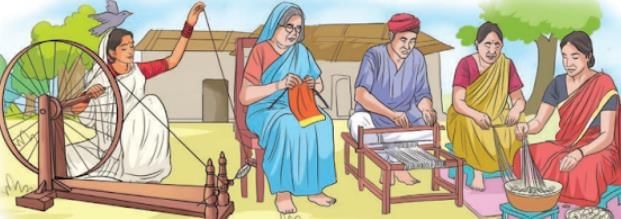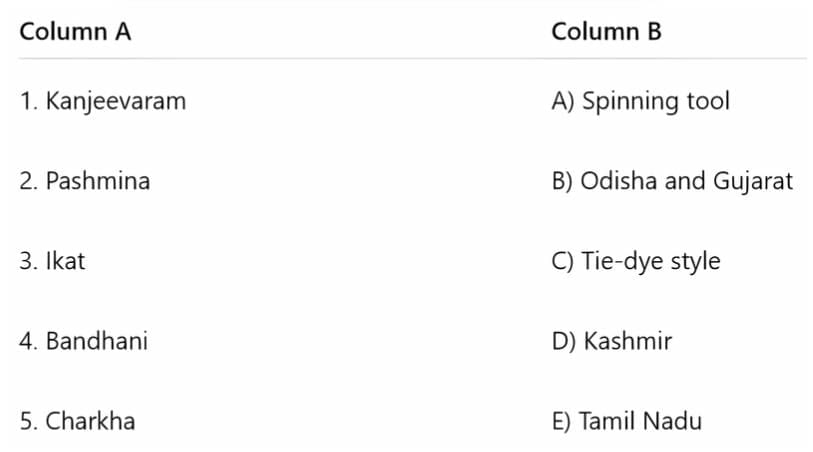Worksheet: Clothes-How Things are Made | Worksheets with Solutions for Class 5 PDF Download

Q1: Choose the correct option for each question.
(i) What do birds like the male baya weaver build their nests from?
A) Plastic
B) Grass
C) Leaves
D) Twigs
(ii) What tool was used to weave fabrics in India 4,000 years ago?
A) Needle
B) Loom
C) Charkha
D) Spinning Wheel
(iii) Which of the following is a unique handloom tradition of Tamil Nadu?
A) Ikat
B) Pashmina
C) Kanjeevaram
D) Bandhani
(iv) What is the process called when cotton fibres are twisted into thread?
A) Weaving
B) Spinning
C) Knitting
D) Stitching
(v) Which material is used to make Pashmina shawls?
A) Cotton
B) Wool
C) Silk
D) Jute
Q2: Match the items in Column A with the correct descriptions in Column B.

Q3: Fill in the blanks with the correct words from the chapter.
(i) The tailorbird stitches big leaves together to make a ______.
(ii) Indian muslin was so fine it was called "woven ______."
(iii) Weaving supports culture and people's ______.
(iv) The process of making thread from fibers using a charkha is known as ______.
(v) Old clothes can be turned into ______ by joining small pieces together.
Q4: State whether the following statements are True or False. Correct the false statements.
(i) The Baya weaver is an expert weaver who makes rough nests.
(ii) Handloom weaving requires the use of electricity.
(iii) Both natural and synthetic fibres are used in clothing.
(iv) The tailorbird uses its beak to sew leaves.
(v) India is the largest producer of silk in the world.
Q5: Answer the following questions in 2-3 sentences each.
(i) What do birds like the male baya weaver do to make their nests?
(ii) How do people in India keep the art of weaving alive?
(iii) What is a charkha, and what is it used for?
(iv) What can you do with running stitches?
(v) How do people recycle old clothes in India?
Q6: Answer the following questions in 4-6 sentences each. Use examples from the chapter to support your answers.
(i) Explain the process of making thread from cotton and how it is used to make cloth.
(ii) How do natural and synthetic fibres differ? Give examples of each type.
(iii) Describe the traditional embroidery work done in different parts of India.
(iv) Why should we recycle and reuse old clothes? How can we do this?
You can find Worksheet Solutions here: Worksheet Solutions: Clothes-How Things are Made
FAQs on Worksheet: Clothes-How Things are Made - Worksheets with Solutions for Class 5
| 1. What are the main types of materials used to make clothes? |  |
| 2. How has the process of making clothes evolved over time? |  |
| 3. What are the steps involved in the manufacturing process of clothing? |  |
| 4. What are some environmental impacts of clothing production? |  |
| 5. How can consumers make more sustainable choices when buying clothes? |  |
















